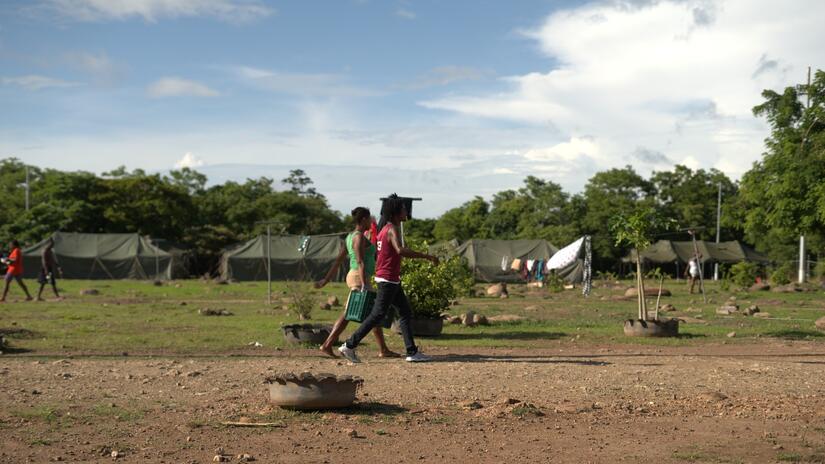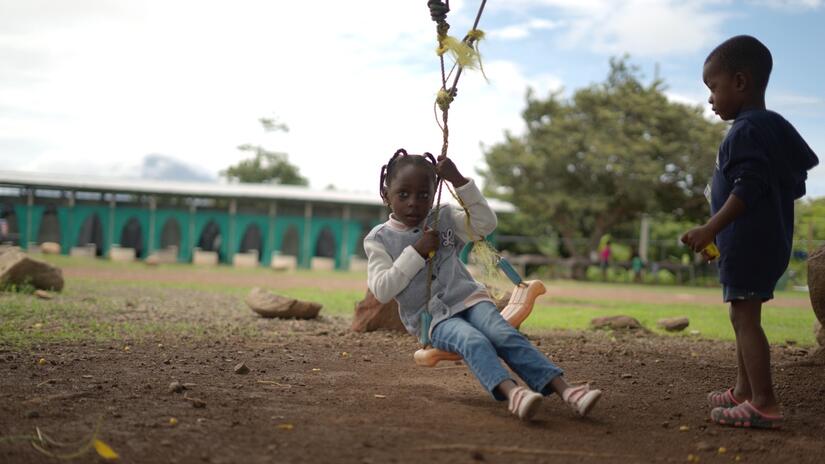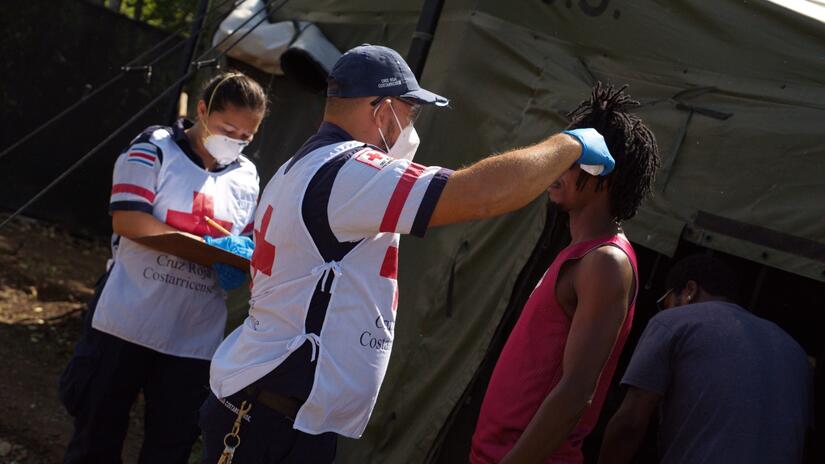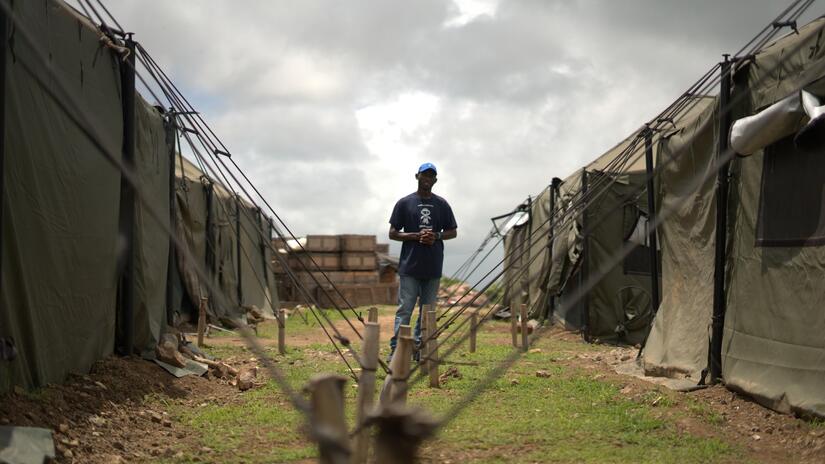Aisha sits in front of a drab green tent in a camp set up for migrants near the Costa Rican border with Nicaragua. It is the rainy season, just as it would be 9,200 kilometers away in Aisha’s home in West Africa. Her journey has been full of tragedy, even before the moment two-years ago, when she decided out of sheer panic to flee her country. She’s passed through Brazil, Peru, Ecuador, Colombia, Panama and now here to this little outpost.
Smugglers, drug traffickers, seemingly impassible jungles – the journey would be hard enough under normal circumstances. Add to that the coronavirus. Migrants like Aisha travel through some of the countries hardest hit by the pandemic – Colombia, Brazil, Panama and Mexico among others – in order to reach the US, which has the highest number of Covid-19 cases in the world.
But the biggest impact of Covid-19 on the lives of migrants has been their ability to move at all. They can no longer transit through government checkpoints. In critical passage areas, migrants are told to stay put until the crisis passes. In Panama, they generally congregate informally in small towns, while in Costa Rica, they often live in government provided temporary shelters where groups such as the Red Cross provide services. Those who choose to avoid official checkpoints and shelters run the risk of even more abuse.
In places like these, the Red Cross and other humanitarian organizations make an effort to keep people in the present. There are multiple activities: volleyball, football, calls to home, as well as critical services such as food and hygiene kits, psychological support and health and hygiene promotion.
In the absence of movement, memory takes over. Aisha thinks of home. It is the place where, until only a month or so before she fled, she had no plans beyond her work as a sociologist, her relationship with her husband in the military and raising her daughter. Now she is so afraid of what might happen to her if she returns to her country, she asks that her real name not be revealed.

Two men carry a crate of supplies through the migrant camp they're sheltering in on the border between Costa Rica and Nicaragua.
Photo: RCRC Magazine/Sebastián Corallo
A summer of fear
In the summer of 2018, Aisha’s husband told her that he was fed up with his military life. One day he was sent on a mission, but his unit deserted instead. “They knew that by refusing an order, they were running the risk of being killed,” Aisha says.
The husband (Aisha asked that his name be withheld for his safety) calculated that he would be arrested at the airport if he tried to flee by air. And so, in September 2018, he reached out to the smugglers’ networks and left on a one-month journey by boat to Colombia.
Men came to visit Aisha with increasing frequency. She didn’t know the visitors who said they were her husband’s “friends,” enquiring as to his whereabouts. “I understood that they were military personnel in civilian clothes,” she says. “I feared for my life and my daughter’s life.”
The plan was to go to Brazil with her 2-year-old daughter Leila and then move onwards to Colombia to meet her husband. “In my country, the Brazilian visa is the fastest you can get,” she said. “My request was easily granted. Since I am a sociologist, I told the authorities that I was going to Brazil to deepen my knowledge of Brazilian culture.”
An American dream
United Nations officials say that Europe’s crackdown on migrant crossing through its borders, along with reports of enslavement in Libya, left smugglers searching for other routes into the West’s most developed countries. Since 2015, smuggling networks outside of the Americas began to explore the long and extremely dangerous route through Latin America to the US and Canada.
For many African migrants, that means they first have to cross an ocean. Samuel, 45, is a barber from Northern Nigeria who had a dream to cut hair in America. He was willing to pay any price, even tempt death in order to live his dream.
In 2016, he made his way from Lake Chad to the Nigerian coast where he was smuggled aboard a ship bound for Colombia. When he boarded, the smuggler told him that he had a 50 percent chance of survival. During the three-month journey he found himself alternatively seasick and starving. That was until the captain of the ship found Samuel in the hold and threatened to throw him into the ocean. It took a concerted intervention by several crewmembers to save his life.
After he landed in Colombia, Samuel (he has asked that his full name not be used) had to confront smugglers, drug traffickers, seemingly impassible jungles – the journey was hard enough until he got to the U.S. border. There, he was apprehended and placed in detention for seven months before being deported back to Nigeria.
But Samuel’s dream was not extinguished. By 2019, after saving up enough money to make the journey again, he was back in Latin America, attempting to make his way northward. Forced by circumstance to remain in Costa Rica, Samuel began again to re-dream his existence. He remembered a talk he had with a border official four years earlier in Costa Rica. “All migrants dream of the United States,” the immigration agent said. “Why can’t you stay in Costa Rica and live your American dream here?”

A young girl whose family are migrating through the Americas after having travelled from Africa plays on a swing in Costa Rica, her future uncertain.
Photo: RCRC Magazine/Sebastián Corallo
Migration in pandemic
Meanwhile, other groups of migrants, predominately from Haiti and Cuba also attempt to move upward through Latin America to the U.S. The journey is remarkably long. There are often children born during the crossing and so the infants generally take on the citizenship of their place of birth. Chilean, Ecuadorian, Panamanian and Costa Rican infants move along the famished road with their families.
Red Cross officials in Central America go to great pains to teach migrants about Covid-19 – the importance of social distancing, hygiene and wearing masks among other things.
“Imagine a migrant who does not have the opportunity to isolate, maintain social distance, earn income to buy food, or have resources to buy masks, disinfectant gel or have running water,” says Jono Anzalone, head of disaster and crisis response for the International Federation of Red Cross and Red Crescent Societies. “How can a migrant protect herself in the middle of this pandemic? “
Moreover, it is a real challenge to get people, whose entire future is predicated on movement from one country to another to accept the dangers of coronavirus.
“They don’t believe that Covid-19 exists,” says Jose Felix Rodriguez, the migration regional coordinator for the IFRC. “They are frustrated because they can’t continue north.”

A Costa Rican Red Cross medical team performs a temperature check on a man staying at the migrant centre on the border with Nicaragua to check for signs of COVID-19.
Photo: RCRC Magazine/Sebastián Corallo
Underlying drivers of migration still strong
Many believe that Covid-related quarantines and border closures have dramatically slowed the flow of migrants. But they doubt that it has stopped it altogether. Migration flows have continued despite the pandemic. The underlying conditions that have driven people to migrate are still present. “The pandemic has not deterred them,” says Anzalone.
The closure of borders has increased the vulnerabilities of migrants transiting through Central America as controls became more rigorous and many were forced to stay in shelters that were unprepared for large groups staying for long periods of time.
Crowding in these shelters, combined with the lack of permanent access to clean water, masks or other protective equipment, as well as the lack of food or other resources, have put many people throughout the region in a very critical situation.
Perhaps the most treacherous part of their journey, however, is through the Darien Gap – a jungled portion of land separating Colombia from Central America.
Those seeking a way northward through Darien travel in groups of about 400 people. Aisha said that each person pays between 20 and 40 dollars for the journey. In the forest, if you can’t walk, you are left behind. In a short period of time, the large group separates into smaller ones of about 100 people – the fastest to the stragglers. “We’ve seen people abandon their families there,” says Aisha. “In the forest, you don’t wait and there are no friends. Everyone is trying to save their lives.”
The perils of the Darien Gap
Inside the Darien, Aisha and her family met a couple from Guinea. The woman was 6-months pregnant. The pair had been left behind by their group. She had vomited blood and lost her child. When Aisha found her, the couple had already spent some six or seven days in the forest alone. “We tried to give them biscuits to eat. But the woman had her feet and face swollen, she couldn’t eat,” Aisha says. The couple made it through the jungle but just barely.
On the fourth day, Aisha saw – with her own eyes – vultures descending into a river. In the water, there was a corpse of a man with black-and-white shoes. “The vultures began to tear the body into pieces.”
To be sure, while the journeys are perilous they are also journeys of hope. If they could cross the myriad borders of South and Central America and make it to the US, Aisha and her family could settle with her uncle who lives in Colorado. “My goal was to get to my uncle’s house in the US and start a new life so that I could continue studying my career as a sociologist,” she says.
“What gives me hope is the life I have right now,” she says. “I have survived in Peru, Ecuador, and the deadly forest so far. If I have survived all this, I know I can make my dream come true by the grace of God.”
--
This story was produced and originally published by the Red Cross Red Crescent Magazine. To learn about the Magazine, and to read more stories like this, click here.

